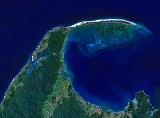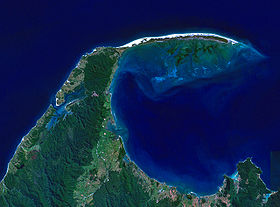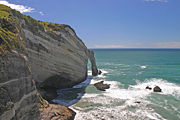
Cape Farewell, New Zealand
Encyclopedia



Headlands and bays
Headlands and bays are two related features of the coastal environment.- Geology and geography :Headlands and bays are often found on the same coastline. A bay is surrounded by land on three sides, whereas a headland is surrounded by water on three sides. Headlands are characterized by high,...
in New Zealand
New Zealand
New Zealand is an island country in the south-western Pacific Ocean comprising two main landmasses and numerous smaller islands. The country is situated some east of Australia across the Tasman Sea, and roughly south of the Pacific island nations of New Caledonia, Fiji, and Tonga...
, the most northerly point on the South Island
South Island
The South Island is the larger of the two major islands of New Zealand, the other being the more populous North Island. It is bordered to the north by Cook Strait, to the west by the Tasman Sea, to the south and east by the Pacific Ocean...
. It is located just west of Farewell Spit
Farewell Spit
Farewell Spit is a narrow sand spit situated at , at the northern end of the South Island of New Zealand. Known to the Māori as Tuhuroa, it runs eastwards from Cape Farewell, the island's northernmost point...
. Discovered by Abel Tasman
Abel Tasman
Abel Janszoon Tasman was a Dutch seafarer, explorer, and merchant, best known for his voyages of 1642 and 1644 in the service of the VOC . His was the first known European expedition to reach the islands of Van Diemen's Land and New Zealand and to sight the Fiji islands...
, it was named by British
Great Britain
Great Britain or Britain is an island situated to the northwest of Continental Europe. It is the ninth largest island in the world, and the largest European island, as well as the largest of the British Isles...
explorer Captain James Cook
James Cook
Captain James Cook, FRS, RN was a British explorer, navigator and cartographer who ultimately rose to the rank of captain in the Royal Navy...
in 1770 - it was the last land seen by his crew as they departed on the ship's homeward voyage.
It is one of the less visited of New Zealand
New Zealand
New Zealand is an island country in the south-western Pacific Ocean comprising two main landmasses and numerous smaller islands. The country is situated some east of Australia across the Tasman Sea, and roughly south of the Pacific island nations of New Caledonia, Fiji, and Tonga...
's major capes due to its remote location. The "Clifftop walk" (2-3 hours one-way along the heights of the coast north of the cape) joins the area with the beginning of Farewell Spit
Farewell Spit
Farewell Spit is a narrow sand spit situated at , at the northern end of the South Island of New Zealand. Known to the Māori as Tuhuroa, it runs eastwards from Cape Farewell, the island's northernmost point...
, and has stunning vistas of the Tasman Sea
Tasman Sea
The Tasman Sea is the large body of water between Australia and New Zealand, approximately across. It extends 2,800 km from north to south. It is a south-western segment of the South Pacific Ocean. The sea was named after the Dutch explorer Abel Janszoon Tasman, the first recorded European...
to one side, of the sanddunes in the northeast and of the towering cliffs and rocky, primal landscapes to the shoreward (east) side.
Geology=
The cape and its cliffs are composed of late Cretaceous
Cretaceous
The Cretaceous , derived from the Latin "creta" , usually abbreviated K for its German translation Kreide , is a geologic period and system from circa to million years ago. In the geologic timescale, the Cretaceous follows the Jurassic period and is followed by the Paleogene period of the...
quartz
Quartz
Quartz is the second-most-abundant mineral in the Earth's continental crust, after feldspar. It is made up of a continuous framework of SiO4 silicon–oxygen tetrahedra, with each oxygen being shared between two tetrahedra, giving an overall formula SiO2. There are many different varieties of quartz,...
sandstone
Sandstone
Sandstone is a sedimentary rock composed mainly of sand-sized minerals or rock grains.Most sandstone is composed of quartz and/or feldspar because these are the most common minerals in the Earth's crust. Like sand, sandstone may be any colour, but the most common colours are tan, brown, yellow,...
s. The erosion of the cliffs into fine sand carried on the sea currents creates Farewell Spit
Farewell Spit
Farewell Spit is a narrow sand spit situated at , at the northern end of the South Island of New Zealand. Known to the Māori as Tuhuroa, it runs eastwards from Cape Farewell, the island's northernmost point...
further east.

